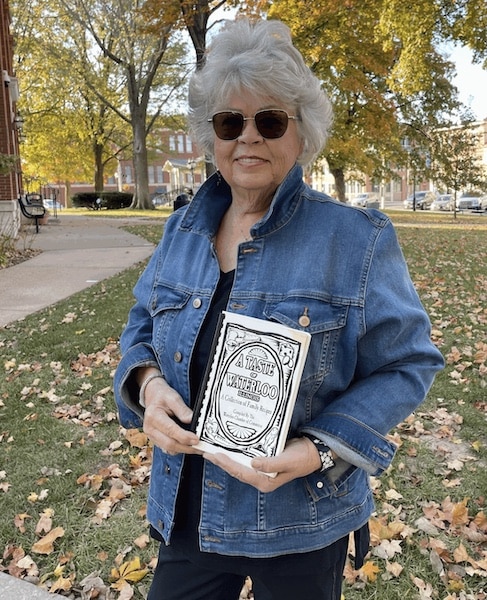Taste Buds | More than a recipe

An online column by Vivanda Felice and Pipa Benoit, pseudonyms for two Monroe County foodies dedicated to supporting and highlighting local food spirit and culture
Community cookbooks seem abundant throughout Monroe County. I have found them on Morrison-Talbott Library’s “free – take one” cart and within Little Free Libraries around town. I also found some at The Backyard Porch, the thrift shop of House of Neighborly Service on West Mill Street in downtown Waterloo. The Nice Twice thrift store had an entire shelf, about 80 in total, identified by their telltale plastic binding. I looked at every single one and snagged six of my favorites.
Seeing these shelved compilations, I lamented, “Has the community cookbook been retired?” For a time, it seemed that every organization, business and town published their own compendium of recipes. But now, they look forlorn on resale shelves. Maybe the spiral bound, sticky pages of favorite recipes, conversion tables, and substitution suggestions have been replaced by Google. When my favorite food blogger includes a pictorial chronology of instructions, along with a TikTok video of her recipe, why guess at the assembly with instructions from a paper cookbook? It is also difficult to deny the efficiency of Google. Typing “ingredient + ingredient + recipe” in the search bar gives me a library of suggestions for dinner. We can feed the family with ingredients on hand instead of zipping to the store for more.
Despite the convenience of technology, I hoard my community cookbooks. The feel of the pages, stained by the ingredients of a former recipe, has a tactile and nostalgic quality. It reminds me of baking alongside my mother from a cookbook assembled by our fellow church members. Our favorite pages were dismembered from the plastic prongs. Beloved recipes on pages behind the “Breads” tab were fused by food remnants.
I have an emotional attachment to my cookbooks. Much of the pleasure of eating, for me, comes from the effort of preparation. A big part of that preparation involves thumbing through the pages of the cookbook, smelling the pages, seeing my old notes from the last time I made the recipe. I particularly love community cookbooks. They provide a glimpse into what was important to that particular group of people, in that specific moment in time.
I recently borrowed Debbie Ruggeri’s “A Taste of Waterloo, Illinois” cookbook, compiled in 2004 when she served as executive director of the Waterloo Chamber of Commerce. The pages of this “Collection of Family Recipes” has a lovely peppery smell. The first page acknowledges the Chamber’s Cookbook Committee Members who championed this labor of love: Tammy Crossin of First Bank, Kevin Johnson of Mid America Mortgage, Rhonda May and Pat O’Riley of Reliable Sanitation, and Lynn Venhaus of Republic-Times. It acknowledges the designer and publishers, Joe Krump of Koerber Distributing and K & D Printing, respectively. This edition is a cook’s cookbook and stands out among others as thoughtfully curated. Reading through the recipes shows me what my banker, my accountant and my jeweler enjoyed eating, and what recipes were important to their family. And it allowed me to quietly judge, or admire, their processes. Food is so intimate for me that studying some of the recipes felt voyeuristic, like Facebook stalking, before social media infiltrated our lives.
When Debbie was hired by the Chamber in 2004, she was new to the area, having just moved to Waterloo from Webster Groves, Mo. She proposed publishing a cookbook, which was warmly received by the members. Gathering the recipes allowed her to learn the area, the businesses and the people. I thumbed through pages of the Chamber cookbook looking specifically for Venhaus’s recipes after learning she was a food editor of the St. Louis Globe-Democrat in the 1980s. She included recipes from regional restaurants including “Mike Duffy’s Bar & Grill Chicken Salad,” the salad recipe from Pasta House, and the “Centralia House Restaurant House Dressing.”
Some recipes are named affectionately after a family member, who enjoyed eating the dish or authored the signature recipe. Ruggeri invites readers to “mangia,” (eat up!) celebrating her Italian heritage with a recipe for Mama Ruggeri’s Pasta E Fagioli, and provides pronunciation for the uninitiated, “Fa-zool.” Similarly, Mark Altadonna honored his Sicilian roots by including Grandpa Altadonna’s recipes. I can’t wait to make his Steak Rolls and Meatball Hamburgers.
Mark was able to submit Grandpa Altadonna’s treasured recipes for the Chamber’s cookbook due to the tireless work of Mark’s cousin Rosalyn and aunt Kathryn Kueper. Rosalyn and Kathryn had cooked alongside Grandpa Altadonna for years, and were familiar with his recipes. Though a list of ingredients and proportions were never memorialized during Grandpa’s lifetime, Rosalyn and Kathryn recreated the recipes later, honoring his culinary legacy by authoring a family cookbook. They compiled these and other Altadonna family recipes as a tribute to him, and in so doing preserved the family’s history and generations of recipes and traditions.
We also found a copy of “The Ahne Family Favorites” cookbook that begins with an Ahne family history. It describes the immigration story of Franz Ahne from Holland and Anna Gepp from Germany in the late 1800s. Much of the history is devoted to the lineage of Franz and Anna’s son, Joseph Ahne, who married Corina Floerke and together had 14 children. A lovely feature of this cookbook is the Index of contributors, listing over 100 descendants and family members. I’d love to see a family tree of this food-loving bunch. We were hoping Ahne’s bakery secrets were revealed within the pages. Jeff Ahne did include his “Fabulous Fettuccine Alfredo” and Gene Ahne offered his pizza dough recipe.
A very special community cookbook that caught our attention was “For the Love of Children,” a collection of recipes by the Children’s Miracle Network committee members of the Waterloo Walmart store in 2007. Like many community cookbooks that served as a fundraiser for the sponsoring organization, the book sale proceeds were donated to Cardinal Glennon and St. Louis Children’s Hospital. Beyond the delicious recipes that bring me into people’s kitchens (Marlene Roberts’ Zucchini Pie, Bridget Dillard’s Chicken with Shallot & Olives), it was a poem in the beginning of the book that caught my attention: “Slow Dance,” written by a terminally ill young girl and sent in by her doctor. The final stanza of the poem:
“Life is not a race.
Do take it slower
Hear the music
Before the song is over.”
Many of the cookbooks offered similar recipes for the soul. Witty idioms, quotes and advice are tucked between recipes. “If you are ever at a loss to support a flagging conversation, introduce the subject of eating,” Leigh Hunt poignantly observed. Similarly Samuel Pepys noted, “Strange to see how a good dinner and feasting reconciles everybody.” Some quips aren’t about food at all, but the social commentary is appreciated just the same: “There are two theories to arguing with women. Neither one works.”
Other cookbooks provide the organization’s history and raison d’être. In “Grade A+ Recipes” by the Friends of Ss. Peter & Paul Catholic School, the school’s history from its founding in 1852 to the 150th graduating class of SPPCS in 2003 is outlined. The Humane Society of Monroe County’s cookbook, “Bone Appétit,” treats us to the organization’s origin story and a few success stories (with photos!) of pets who’ve been rescued.
Our regional community cookbooks had a commonality of recipes. Strong showings were made by Cheese Balls in the appetizer sections, by Jello Salads and Hot German Potato Salad in the next section, various chilis behind the entrees tab, and Gooey Butter Cakes in the dessert section finales. “For the Love of Children,” featured six cheese ball recipes – every single one, unique. Joyce Veath’s Philly Cheese Ball recipe uses pimento, green pepper, and onion – in stark contrast with her Corned Beef Cheese Ball, which calls for green onion and corned beef (chipped fine). Jill Webb’s Cheese Ball has olives, while Jean Reis’s has dried beef and horseradish. And I want to try. Every. Single. One.
Our foray into exploring community cookbooks, then sitting down to write this article, made us appreciate that there is so much more to a cookbook than a recipe. And that there is much more we want to share with you about our discoveries, our dear readers. So stay tuned for more as we delve into these treasures.
Spoiler alert: We’ll actually be cooking up some recipes from these delectable delights.






